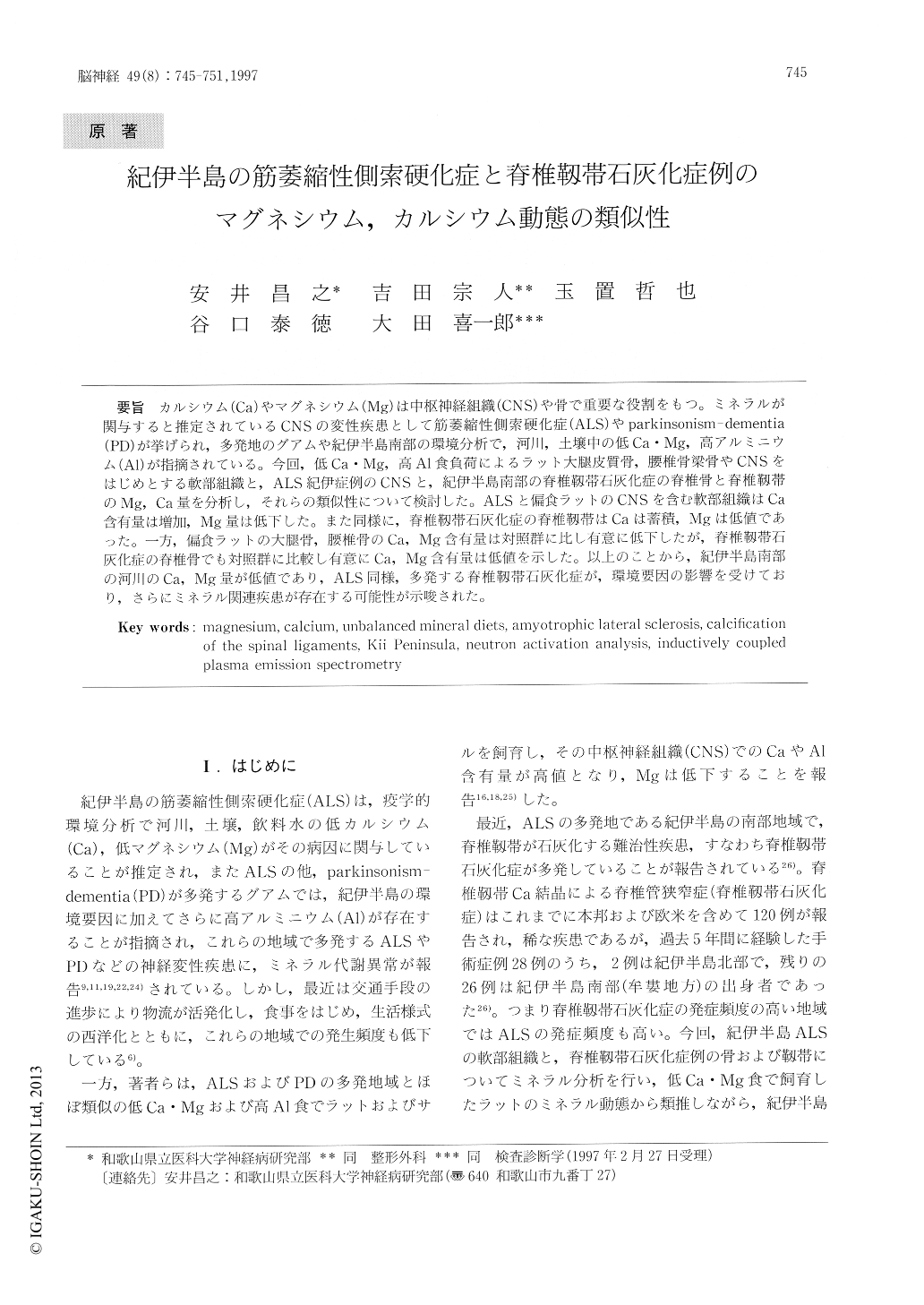カルシウム(Ca)やマグネシウム(Mg)は中枢神経組織(CNS)や骨で重要な役割をもつ。ミネラルが関与すると推定されているCNSの変性疾患として筋萎縮性側索硬化症(ALS)やparkinsonism-dementia(PD)が挙げられ,多発地のグアムや紀伊半島南部の環境分析で,河川,土壌中の低Ca・Mg,高アルミニウム(Al)が指摘されている。今回,低Ca・Mg,高Al食負荷によるラット大腿皮質骨,腰椎骨梁骨やCNSをはじめとする軟部組織と,ALS紀伊症例のCNSと,紀伊半島南部の脊椎靱帯石灰化症の脊椎骨と脊椎靱帯のMg,Ca量を分析し,それらの類似性について検討した。ALSと偏食ラットのCNSを含む軟部組織はCa含有量は増加,Mg量は低下した。また同様に,脊椎靱帯石灰化症の脊椎靱帯はCaは蓄積,Mgは低値であった。一方,偏食ラットの大腿骨,腰椎骨のCa,Mg含有量は対照群に比し有意に低下したが,脊椎靱帯石灰化症の脊椎骨でも対照群に比較し有意にCa,Mg含有量は低値を示した。以上のことから,紀伊半島南部の河川のCa,Mg量が低値であり,ALS同様,多発する脊椎靱帯石灰化症が,環境要因の影響を受けており,さらにミネラル関連疾患が存在する可能性が示唆された。
3 0 0 0 OA 倉敷川畔伝統的建造物群保存地区における自主条例による町並み保全・整備に関する研究
- 著者
- 吉田 宗人 出口 敦
- 出版者
- 日本建築学会
- 雑誌
- 日本建築学会計画系論文集 (ISSN:13404210)
- 巻号頁・発行日
- vol.81, no.729, pp.2443-2451, 2016 (Released:2016-11-30)
- 参考文献数
- 10
- 被引用文献数
- 2
Kurashiki Gawahan Preservation District is renowned as the first implementation area of ordinance for historical preservation of buildings executed by a municipality. Two ordinances have been applied to the surrounding area of preservation district; Traditional Aesthetic Ordinance (TAO) and Background Preservation Ordinance (BPO). The preservation district has maintained the historical townscapes inheriting since Edo Era, and has recently experienced the increasing of tourists. This study aims to clarify the effects and the issues of the local ordinances executed by a municipality (Kurashiki City) to the preservation and improvement of townscape in from the following aspects; 1) repairs and restorations of historical buildings, 2) control of building construction and historical buildings demolition, 3) Recreation of exterior building facade, 4) improvement of street. The objectives of this research are as follows; 1) To make arrangement of the achievements and impacts of the ordinance application to the historical preservation of buildings in the implementation area, and clarify the trend of preservation projects. 2) To point out the roles of the ordinances for each period, and to clarify the efficiency and the issues of preservation and improvement of townscape from the above-mentioned five aspects. Through the analysis on whole the cases of stored or improved buildings implemented from 1979 till 2014 with TAO (179 cases), and BPO (10 cases), this study concludes by clarifying the efficiency as follows; (1) Efficiency from view of historical building repairing and restoring In the year 1979, all the restored historical buildings were limited within the preservation district, but since 2007, the restoration has been applied into the traditional aesthetic district, which has made the preservation of historical townscape expanded around the preservation district. (2) Efficiency from view of control of building construction and historical building demolition At the beginning of enactment of TAO, to avoid the breaking of townscape around the historical district, the building construction has been controlled in the surrounding area, which led to enlarge the preservation district substantially. The efficiency of BPO was the restriction of development by the local government. (3) Efficiency from view of recreation of exterior building facade Due to the improvement of street connecting the preservation district and the surrounding areas, the historical townscape was re-created by the local government. (4) Efficiency from view of improvement of street In few number of tourist-oriented streets connecting to the preservation district, one of streets in the traditional aesthetic district was improved to be a tourist-oriented street based on TAO, which led to increase the number of tourists. Due to the preservation and improvement of townscape based on TAO and BPO, a buffer zone around the preservation district was formed. Especially, TAO has been effective in creating a new pedestrian flow which led to revitalize the surrounding area. On the other hand, this study suggests the issues relative to the roles of ordinances for the future development of the preservation surrounding area by pointing out the possible negative impact of the ordinances to the change of building use from residential-oriented to tourism-oriented.
- 著者
- 三浦 詩乃 吉田 宗人 田中 伸治 有吉 亮
- 出版者
- 日本建築学会
- 雑誌
- 日本建築学会計画系論文集 (ISSN:13404210)
- 巻号頁・発行日
- vol.86, no.781, pp.949-959, 2021-03
1 0 0 0 脊髄硬膜外血腫の検討
- 著者
- 安藤 宗治 川上 守 橋爪 洋 南出 晃人 吉田 宗人
- 出版者
- 中部日本整形外科災害外科学会
- 雑誌
- 中部日本整形外科災害外科学会雑誌 (ISSN:00089443)
- 巻号頁・発行日
- vol.47, no.6, pp.1187-1188, 2004 (Released:2005-04-28)
- 参考文献数
- 6

